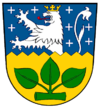Eiweiler (Heusweiler)
Eiweiler is a district of Heusweiler in Saarland .
history
Between 1936 and 1940, Siegfried Line bunkers were created in the municipality. On December 5, 1944, 16 people died in an attack on the railway line ( Lebach – Völklingen line ) in Eiweiler. Most of them were evacuees from Völklingen . On March 18, 1945, German soldiers blew up the local railway bridge. It was rebuilt in 1947.
In a mining accident in Luisenthal on February 7, 1962, six miners from Eiweiler died.
In 1936 Eiweiler, Hellenhausen and Kirschhof were merged to form a civil parish. From 1966 to 1973 Eiweiler was self-employed as a non-governmental municipality. On January 1, 1974, Eiweiler was incorporated into the community of Heusweiler.
religion
A large part of the population is Catholic. This has to do with the former belonging to the Schwarzenberg and Dagstuhl lordship as well as the ecclesiastical ties to Mettnich , which existed until 1826. However, the Counts of Nassau-Saarbrücken introduced the Reformation in Eiweiler in 1575 and enforced it to such an extent by 1581 that no Catholic clergy was there any more and Catholic services were no longer allowed to be held. Later, however, the community was strengthened again by Catholic immigrants. At first it was only possible to attend church services in Wadgassen , from 1660 also in Heusweiler , but under French administration, the church in Eiweiler was returned to the Catholics in 1684.
Sacred buildings
The church , which was badly damaged around the middle of the 17th century , was probably replaced by a new building around 1750; a little earlier the Heilig-Geist-Kapelle was built on Vogelsborn. In 1850 the parish church was expanded. Between 1880 and 1885, as part of the Kulturkampf, any pastoral care was forbidden by the Prussian government, after which the community revived. In 1903 the parish church received two bells, in 1923 a cemetery was set up and in 1924 a new rectory was built. In 1937 a large part of the church building was replaced by a new building and in 1938 the chapel on Vogelsborn was also renovated, which was replaced by a new building in 1970. In 1959 the nave was also rebuilt. In 1962 the church received five new bells and in 1966 an organ that Hugo Meyer had built in Heusweiler. The chapel at Vogelsborn has been surrounded by an artistically designed way of the cross since the beginning of the 21st century.
Attractions
Stone sculptures of the Fourteen Holy Helpers can be seen in the church, which was built in 1959 . Remnants of the previous building of the church have been preserved. In the church there is also a memorial to the victims of the wars and the mines.
Economy and Infrastructure
Until the 1950s, the inhabitants mostly lived from agriculture, coppice forest management and mining in the area. After the tanned hedges , which characterized the Eiweiler area, had become economically uninteresting because the tanneries had switched to chemical tanning agents and the use of firewood was no longer generating enough profit, the work was directed towards high forest management.
The Großwald brewery was founded as early as 1860 .
Above all, however, the woodworking industry settled in Eiweiler. In 1946 a plywood and veneer factory was built. A chipboard factory (formerly Novopan, Glunz AG, Tarkett ), today Laminate-Park , has existed in Eiweiler since 1953 .
traffic
The Eiweiler stop is on the Lebach – Walpershofen railway line and is served by Saarbahn trains on the Lebach-Jabach - Heusweiler - Saarbrücken route.
Education and culture
Since 1962 there has been a school building on Großwaldstraße in Eiweiler, which houses a primary school. A gymnasium and swimming pool are part of the primary school. In 1969 the foundation stone for a kindergarten was laid. Today, this kindergarten belongs to the Püttlingen model facility together with three other institutions .
Regular events
Every year a fair takes place around the day of St. Erasmus of Antioch , who has been the patron saint of the Catholic Church in Eiweiler since 1569 at the latest. After the high mass, the parade moves from the church to the fairground. A mass is celebrated on the Monday after the fair. The so-called traditional "Kerwehannes", a straw doll, is lit at the end.
Individual evidence
- ^ Federal Statistical Office (ed.): Historical municipality directory for the Federal Republic of Germany. Name, border and key number changes in municipalities, counties and administrative districts from May 27, 1970 to December 31, 1982 . W. Kohlhammer, Stuttgart / Mainz 1983, ISBN 3-17-003263-1 , p. 806 .
